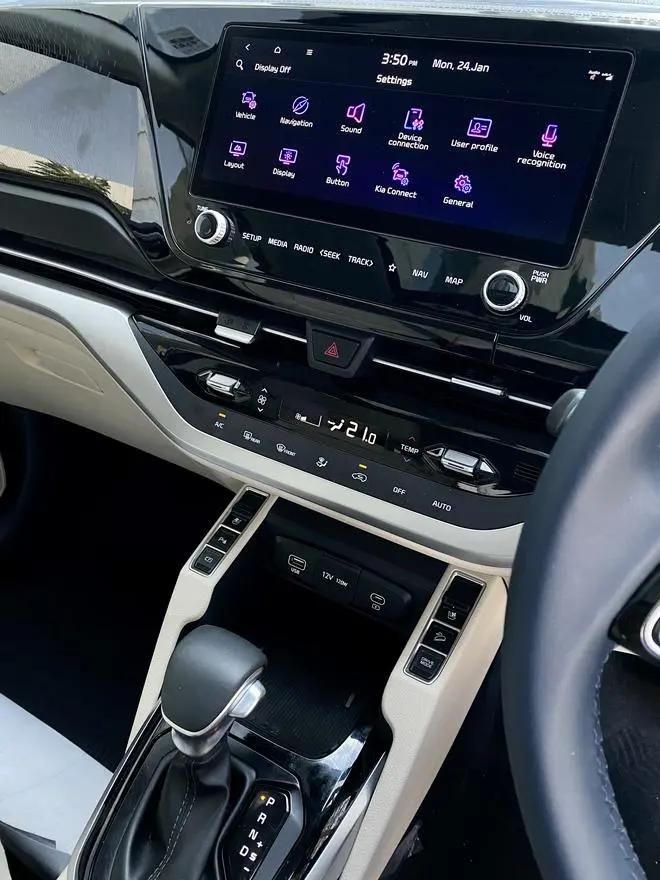The sports utility vehicle body-style is growing in popularity so fast that it is likely to overtake the hatchback this year. The versatility of the SUV, its all-weather road-worthiness, and its ability to tackle roads where none exist, have become reasons for the preference long after the novelty of the body-style faded. And by extension, we Indians now prefer our family tourers to also look like and drive like SUVs.
The 3-row SUV is now threatening to overthrow the family van or MPV (multipurpose vehicle) from its perch. And brands are joining the bandwagon in quick succession.

The next in line is the Kia Carens which is due to be officially launched next month. Built on the same platform as the Seltos, and sister brand Hyundai’s Creta and the Alcazar, the Carens is attempting to deliver on size and space while continuing Kia’s brand attributes of appealing design and novel features.
Exterior
The Carens was unveiled in December last year and much has already been said about the exterior design of this 3-row SUV. But there was still much to discover about its design when I walked up to it in Bengaluru last week. The ‘Star Map’ design LEDs above the main headlamps and the EV-style treatment for the glossy, clouded glass bonnet grille area stands out. The front fender features a huge airdam style intake area with a chrome frame and within that a reinterpretation of the Kia Tiger nose. The peeled back headlamp, the connected tail-lamps at the rear and the semi-circular wheel arches give it some shared references with the Seltos. The rear design’s highlights are the wrap-around tail-lamps and the textured chrome garnish on the rear fender that visually accentuates the width of the Carens. The tail-lamps sit on the haunches and a character line that runs from the headlamps into the tail-lamp assembly adds more SUV flavour.

It is only when the Carens is viewed from the side that the impact of its size registers. At 4,540mm long and with a 2,780mm wheelbase, the Carens’ is one of the longest in the segment. Its wheelbase is more than the Hyundai Alcazar and more than even the Toyota Innova. The interesting point here is how design can be deceptive, something that will be better understood when you consider that the Carens is longer, wider and taller than the Alcazar. The longer wheelbase, and consequently shorter overhang at the rear, helps the Carens with its excellent on-road stance, delivering the impact of a large, upright SUV. But does it deliver on the promise of a spacious cabin?
Interior
The Carens is being offered with the 7-seat configuration for the base (Premium) trim to the top-trim (Luxury Plus) variants. But the 6-seat configuration will only be available with the top-trim. The Luxury Plus 6-seat variant gets captain seats for the second row. The third-row set of two seats won’t be comfortable during long drives for adults. But for children it can be adequate, though under-thigh support may not be enough. Folding the third row offers enough boot space for a week’s worth of luggage for a family. With all three rows in use, the boot can handle a couple of medium-sized suitcases (216-litres).

I was tempted to checkout the dashboard in my top-trim test mule, but I decided to try out the rear seats first. Likely many of the owners of the Carens will be spending time here, instead of behind the wheel. Two of the best features for rear seat passengers are the roof-mounted, dedicated aircon vents for the second and third row, and the one-touch electrical fold and tumble for the left hand side (kerb-side) caption seat in the second row. Access to the third row is, as a result, fairly easy. Of course, roof-mounted aircon vents means that the Carens only gets a small sunroof right above the front seats. I certainly didn’t miss a panoramic sunroof.

My Luxury Plus test mule’s dashboard was teeming with features. First observation for me was the way the design of the dash is curved and set forward allowing the driver to sit a bit more ahead. This will certainly be appreciated by women, who will also like the seat adjustments offered. The dashboard features a layered design that is further accented by the use of glossy, textured and matt materials and surfaces. Point to note for competitors is how glossy plastic surfaces need not seem tacky and can still feel upmarket simply with the addition of subtle designs and textures. The centre console is set low with just the gearstick, wireless charging slot and a handful of controls, including for the ventilated seats, being the only occupants right below the centre stack. Just above these is the auto aircon controls and the 10.25-inch touchscreen navigation/ infotainment display. The screen is also the interface for Kia Connect features with as many as 66 connected car functions, 11 of which are unique to the Carens. The top-trim variants are being offered with an embedded SIM card and a 3-year subscription to enable these functions and also OTA (over-the-air) updates.
In addition to door pockets, there are a whole bunch of innovative storage options in the Carens including an under seat tray, cooled cup holders, a retractable seat back table with a gadget mount, and even a pop-out coin tray and cup holder on the dashboard. Depending on the trim variant, some of the other features in the cabin include 64-colour LED ambient lighting, an 8-speaker BOSE music system, and an air purifier with bacteria and virus filters. Cabin space is one of the biggest USPs that Kia claims for the Carens and it is said to offer the most kneeroom and shoulder room in both the second and third rows compared the competition.
Performance

The new Carens is being offered with the same set of three engines and three gearbox options that the Seltos was offered with. The powertrains are being offered in the same state of tune, which means that they deliver the same output levels. I test drove the 1.5-litre diesel and the 1.4-litre T-GDi petrol engine in Bengaluru. The 3-row Carens is a heavier vehicle compared to the Seltos, though not by much. So, I was expecting to find the powertrains a bit underpowered in this vehicle. But, my assumption turned out to be wrong. The Carens feels as nimble and quick off the mark as the Seltos did. Both the engine versions I drove featured automatic gearboxes. The 1.5 CRDi diesel engine with VGT (variable geometry turbocharger) delivers 115PS of peak power and 250Nm of torque. I drove the 6-speed torque converter automatic and found it to be very similar in character to the Seltos with the same powertrain. Peak torque is available from a low 1,500rpm, which means just a light tap on the throttle since idling is set at 800rpm. Typical diesel engine noise does seep into the cabin when the needle crosses 3,000rpm, but it doesn’t get annoying at any time.
The Smartstream 1.4-litre, T-GDi, turbocharged petrol engine delivers 140PS of peak power and 242Nm of peak torque (same as in Seltos). My test mule was the 7-DCT auto gearbox. This powertrain makes the Carens feel even more agile and the dual-clutch transmission delivers smooth, quick shifts. It is also sounds refined and has no dearth for low-end torque; useful while driving within city limits. I got a mileage of about 15.9kmpl from the 1.5L diesel version and about 11.9kmpl with the 1.4L petrol; both with more highway than city driving cycle. Both these engines are also offered with 6-speed manual transmissions. There are three drive modes to choose from - Eco, Normal and Sport, and there is also the option of manual gear selection thanks to steering-mounted paddles.
The other engine on offer is the 1.5-litre Smartstream petrol engine that generates 115PS of power and 144Nm of torque. My guess is that this would feel underpowered, especially with a fully-loaded cabin. Some of that could be offset by judiciously using the 6-speed manual, which is the only transmission on offer for this engine.
The Caren’s ride quality is pretty sorted. The suspension set up does deliver a composed ride on most tarmac conditions. There is a bit of body roll and quick lanes changes is the only time I felt the size of vehicle at the wheel. But there is no dearth of poise when taking turns at speed or for that matter in straight line stability. The rear suspension springs and damping has been tuned for a more rounded ride quality. The steering set up is predictably over-assisted for ease of use in city. It does weigh up at highway speeds. The braking performance is good with disc brakes all around.
Bottom Line
The Kia Carens’ is the first vehicle to focus extensively on safety. Six airbags and a bunch of nine other safety features are part of standard fitment across variants. The convenience of a 3-row SUV in offering more space in the boot or in a pinch being able to offer a couple of extra seats is a big reason for this vehicle type’s increasing popularity. The Carens fits nicely into this segment while offering a number of differentiators for young buyers looking for an aspirational vehicle. With its excellent fit and finish quality and a wide choice of trim and powertrains there will be a Carens variant available across a fairly spread out price range. I expect the Carens to be priced in the Rs 15 lakh to Rs 19 lakh range.






Comments
Comments have to be in English, and in full sentences. They cannot be abusive or personal. Please abide by our community guidelines for posting your comments.
We have migrated to a new commenting platform. If you are already a registered user of TheHindu Businessline and logged in, you may continue to engage with our articles. If you do not have an account please register and login to post comments. Users can access their older comments by logging into their accounts on Vuukle.